Lake Chelan Tour |
WOLVES |
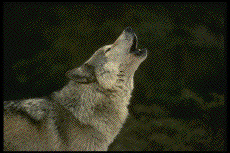 Wolves in the North Cascades: Questions and Answers Among the rare animals living in the North Cascades Mountains is one that may surprise you - the wolf. North Cascades National Park and its neighboring public lands in Washington and British Columbia are an impressive expanse of wild country. These lands preserve the hope that animals now rare will have room to live. The wolf's presence here, though in numbers much reduced from long ago, is testimony to the wildness of these mountains. What is it about the wolf that fires people's imaginations, repelling some and attracting others? Wolves are shy, intelligent animals with complex social structures. Can we distinguish between the reality of the wolf and the legends we have created? Can we accept this fabled predator as part of the diversity of life on earth, occupying its well-earned niche in the scheme of things? Can we enjoy its howl in the North Cascades where it can roam free? The questions and answers here provide pertinent information about wolves and their status in the North Cascades. WOLF SIGHTINGS & DISTRIBUTION 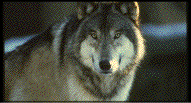 Where have wolves been seen in the North Cascades?
Where have wolves been seen in the North Cascades? Since 1984, wolves have been seen roaming in the vicinity of Ross Lake (Ross Lake National Recreation Area in Washington and Skagit Valley Recreation Area in British Columbia) on both sides of the International Boundary. Wolves were photographed near Hozomeen at the north end of Ross Lake in 1991. Locations of other sightings in the North Cascades include McAlester Pass, Pasayten Wilderness and Twisp River drainage of the Okanogan National Forest, Glacier Peak Wilderness, and Stevens Pass. What kinds of wolves are they? Gray wolves (Canis lupus), sometimes called timber wolves. This species once roamed much of North America from Alaska to Mexico -- from the Atlantic to the Pacific. How many gray wolves are there in the North Cascades? No one knows but probably very few. No one knows whether the population is increasing, decreasing or remaining the same. Are there gray wolves in Washington State outside the North Cascades? Yes. Wolves have been sighted throughout the Cascade Range and in the Selkirk Mountains in the state's northeast corner. Are gray wolves reproducing in the North Cascades? In 1990, adults with pups were seen in the Hozomeen area. This was the first known reproduction of wild wolves in Washington State in at least 50 years! Since 1990, biologists have seen three separate groups of adult wolves with pups in the Cascades. Wolves mate in February or March. About 63 days later a litter averaging six pups is born. What about gray wolf numbers in the rest of North America? Gray wolves once roamed the continent from as far north as the Arctic to as far south as Mexico. Today they occupy about one percent of their former range in the contiguous United States. More than 1,000 gray wolves live in northern Minnesota. Small populations live in Wisconsin and Michigan. Ten to 15 more live in Michigan's Isle Royal National park and about 30 in or near Montana's Glacier National Park. Gray wolves are common, however, in Alaska and parts of Canada. HISTORY OF WOLVES 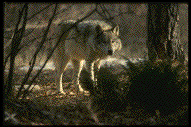 How long have wolves been in the North Cascades?
How long have wolves been in the North Cascades?Since about 10,000 years ago when the last ice sheets retreated. Wolves migrated from the southern Great Plains into the Cascades. For thousands of years, wolves and humans lived in harmony with each other. What caused the decline of wolves? Extensive trapping of wolves for their pelts began with the arrival of the Hudson's Bay Company in the American Northwest in 1821. From 1827 thru 1859, buyers at the company's forts around the North Cascades purchased 7,761 wolf pelts from trappers. The wolf population was further reduced by bounties and trappers employed by the government. Wolves were thought to be eliminated in Washington by the 1930s although unconfirmed evidence of transient wolves occasionally turned up in later years. So how did the wolves now being seen in the Cascades get here? It is likely that many of them moved south from British Columbia. What is the history and status of wolves in British Columbia? As in the United States, wolves were considered undesirable and were aggressively trapped and poisoned. Canada has classified them as big game animals, and they are hunted in parts of British Columbia. Wolf control in southern British Columbia has eased over the last several decades, and according to British Columbian biologists the population of wolves in the province is on the rise. Regulations forbid hunting of wolves just north of the North Cascades National Park/Ross Lake National Recreation Area in the Canadian Skagit Valley Recreation Area and in the Manning Provincial Park. Rapid growth in human population fragmenting of habitat with possible long-term negative consequences for wolf populations. Wolf Facts •Wolves have very well developed senses: They can hear rodents moving under heavy snow over and other wolves howling from several miles distant. They can smell prey more than a mile away. •Wolves run on their toes. This lengthens their legs and makes it possible for them to run faster and turn more quickly. •There are probably fewer than 2,500 wolves in the whole United States today, outside of Alaska. •Every dog in the world is descended from wolves that were tamed in the Middle East about 12,000 years ago. •A wolf's winter coat is very woolly, and can be two and one-half inches thick with individual hairs as long as five inches. DESCRIPTION & BIOLOGY 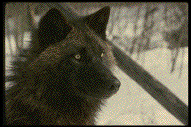 What does a wild wolf look like?
What does a wild wolf look like? A lot like a big dog -- because dogs descended from wolves. But a wolf has longer legs, bigger feet, and a narrower chest than large domestic dogs. While a domestic dog's tail may curl, a wolf's does not. In distinguishing wolf tracks from those of large dogs, size is ineffective. Is a gray wolf gray? The "gray" wolf coat may vary in color from pure white to coal black. The usual color is not gray but light tan or cream mixed with brown, black, and white. Much of the black is concentrated on the back, the forehead tends to be brown, and the lower part of the head and body are whitish. How do you tell a wolf from a coyote or dog? It isn't easy. Wolves howl, whimper and rarely bark. Their howling is described as haunting by some, mournful by others who have heard them in the wild. The call of adult wolves differs from that of coyotes and dogs. It is a long and clear howl not interrupted by short yaps and barks. Distinguishing wolves from coyotes and dogs is different especially when lighting is poor, sighting is brief, or the animal is at a great distance. In general, adult wolves are much larger than coyotes. Coyote colors rarely vary while wolf colors vary widely, and solid-colored wolves are common. It must be remembers that although they resemble their domestic cousins, wolves are not dogs. They're wild and meant to stay that way. Nature dictates that the wolf be an efficient predator in order to survive. While fulfilling this role the wolf occupies an important niche in the ecosystem.  Coyote: Height at shoulder: 16-20 inches, Weight: 20-30 pounds, Color: All shades of gray and tan, even spotted. Coyote: Height at shoulder: 16-20 inches, Weight: 20-30 pounds, Color: All shades of gray and tan, even spotted.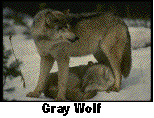 Wolf: Height at shoulder: 26-34 inches, Weight: 70-115 pounds, Color: Black, white, all shades of gray and tan, grizzled all over, never spotted.
What happens when wolves and dogs interbreed? Wolf: Height at shoulder: 26-34 inches, Weight: 70-115 pounds, Color: Black, white, all shades of gray and tan, grizzled all over, never spotted.
What happens when wolves and dogs interbreed? People sometimes breed wolves and dogs creating wolf hybrids that can be mistaken for wolves. However, hybrids can breed with wild wolves, resulting in a wild wolf population with less "wild" genetic structure, and thus, less chance for survival in the wild. Hybrids make undesirable pets. Attacks upon people and livestock by hybrids may lead people to incorrectly expect similar behavior from wild wolves and hamper wolf recovery. Hybrids seldom survive long in the wild. What do wolves eat? Wolves eat mostly mammals such as moose, elk, deer, beaver and marmot. They were probably the major predator in the North Cascades for thousands of years until the later 19th century. Wolves often eat the sick, weak, diseased, injured, and the very young or old. Removing these animals supports the vigor of the prey species population. Are wolves dangerous to humans? Is it safe to hike or camp in wolf country? Wolves in the wild are afraid of humans and generally avoid contact with them. There are no documented instances of healthy wolves attacking humans in North America and only one instance of a rabid wolf doing so. Perhaps some of the widespread fear of wolves is the result of encounters with dogs allowed to run wild. Most places where wolves roam, people are not even aware of their presence. I've heard that wolves are very social. Wolves live in family groups called packs made up of two to 12 or more members. Packs are governed by an Alpha par, usually the only pair to breed. Although an average of six pups are born, few survive the rigors of their first year. Wolves are highly intelligent and communicate with each other by scent marking, vocalizations, and facial and body posturing. Howling helps them keep track of each other, establish territories, assemble the pack, and defend a kill. They may also sometimes howl just for the fun of it. What is being done to learn more about wolves in the North Cascades? Wolves are being monitored by personal observations and surveys, which include howling, self-activated cameras, and track scent stations. Attempts to radio collar a wolf in the North Cascades have been unsuccessful so far, limiting knowledge of how many wolves are present and what areas they are using. Land managers need accurate and more complete information to better support wolf conservation. STATUS AND FUTURE OF WOLVES 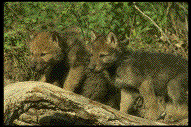 What is the status of gray wolves in the United States?
What is the status of gray wolves in the United States?They are listed as endangered by the U.S. Fish and Wildlife Service in 47 states, meaning that throughout all or in a significant portion of its range the gray wolf is in danger of becoming extinct. The Fish and Wildlife Service has listed the wolf as threatened in Minnesota, indicating it is somewhat more secure from extinction there. In Washington State, both the federal and state governments list the wolf as an endangered species. What protection does this listing provide the wolf? The Endangered Species Act, passed in 1973, requires the federal government to protect and conserve species threatened with extinction. The Act makes the "take" of wolves a violation. As defined in the Act, "take" means to "harass, harm, pursue, hunt, shoot, wound, kill, trap, capture, or collect, or to attempt to engage in any such conduct." Will wolves be recovered in the North Cascades? It is mandatory under the Endangered Species Act that federal agencies work toward the wolf's recovery. Recovery is defined as having a population of adequate size and composition to make survival over the long run likely. The wolf recovery program for the Northern Rocky Mountains, prepared by the U.S. Fish and Wildlife Service, includes all of Washington State. Specific population goals for the North Cascades have not yet been determined. Is there a plan to manage wolves? The U.S. Fish and Wildlife Service is the lead agency for protection and recovery of endangered species in the United States. Several natural resource agencies are working toward the conservation and management of the species, including: Animal Damage Control, Bureau of Indian Affairs, U.S. Bureau of Land Management, U.S. Fish and Wildlife Service, U.S. Forest Service, National Park Service, the Washington Department of Fish and Wildlife, and the British Columbia Ministry of the Environment. Are there plans to bring wolves into the North Cascades? No. It appears that wolves are recolonizing their former habitat. Wolves' ability to disperse over long distances and reproduce prolifically may enable the species to reestablish itself in Washington. If wolf numbers increase in the North Cascades ecosystem are any likely to kill and eat domestic sheep or cattle? Wolves rarely prey on domestic stock, but such incidents do happen. Wolves that kill livestock are removed from the area by experts employed by the federal government. Plans have been developed to deal with problem wolves if livestock losses occur in Washington. What threatens the survival of wolves? The loss of habitat, reduction in prey species, and human-induced mortality are the largest threats to their survival. Attitudes about wolves that stem from stories of "the big bad wolf" and sensational journalism may affect their survival even today. Sources of human-induced mortality include poaching, misidentification as coyotes, or as in British Columbia, through predator control and hunting programs. GETTING INVOLVED  What can I do?
What can I do?If you see a wolf-like animal or its sign, observe its behavior and appearance, and report as quickly as possible by calling 1-800-722-4095. Protect, but do not disturb, tracks or droppings. Take pictures and make notes as soon as possible and record the location. Learn more about wolves to distinguish between legend and reality. Read both popular accounts and scientific reports to satisfy your curiosity and make intelligent choices about the future of these animals. Express your opinion. What is the bottom line? In order for wolves to survive, they need adequate prey and habitat where they can live, hunt, and raise their young without being shot or trapped. Biologist believe that protected areas such as in the North Cascades National park are the key to the wolf's long term presence in Washington. Ultimately, whether wolves will permanently return to the state largely depends on the value people give to their continued existence. |
 BACK TO ANIMALS
BACK TO ANIMALS